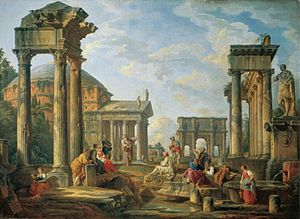Patrimonio cultural
O patrimonio cultural é a herdanza de elementos tanxibles e intanxibles dun grupo ou sociedade que procede das xeracións pasadas. Non todos os patrimonios das xeracións pasadas son “patrimonio”; máis ben, o patrimonio é un produto da selección pola sociedade.[1]

O patrimonio cultural inclúe a cultura material (como edificios, monumentos, paisaxes, libros, obras de arte e artefactos), a cultura inmaterial (como o folclore, as tradicións, a lingua e o coñecemento) e o patrimonio natural (incluíndo paisaxes culturalmente significativas e a biodiversidade).[2] O termo tamén se usa a miúdo en relación coa protección da propiedade intelectual indíxena.[3]
O acto deliberado de manter o patrimonio cultural do presente para o futuro coñécese como preservación, e é o que promoven os museos e os centros culturais, étnicos e históricos, aínda que estes termos poden ter significados máis específicos ou técnicos nos mesmos contextos. O patrimonio preservado converteuse nunha áncora da industria turística global, un importante contribuínte de valor económico ás comunidades locais.[1]
A protección legal dos bens culturais comprende unha serie de acordos internacionais e leis nacionais. As Nacións Unidas, a UNESCO e Blue Shield International ocúpanse da protección do patrimonio cultural. Isto tamén se aplica á integración de Forzas de Paz da ONU.[4][5][6][7][8][9]
Notas
editar- ↑ 1,0 1,1 Logan, William S. (2007). "Closing Pandora's Box: Human Rights Conundrums in Cultural Heritage". En Silverman, Helaine; Ruggles, D. Fairchild. Cultural heritage and human rights. Nova York: Springer. ISBN 9780387713137. OCLC 187048155.
- ↑ Ann Marie Sullivan, Cultural Heritage & New Media: A Future for the Past, 15 J. MARSHALL REV. INTELL. PROP. L. 604 (2016) https://repository.jmls.edu/cgi/viewcontent.cgi?article=1392&context=ripl
- ↑ "Indigenous Cultural and Intellectual Property (ICIP) (AITB)". Arts Law Centre of Australia. Consultado o 21 de xullo de 2021.
- ↑ "UNESCO Legal Instruments: Second Protocol to the Hague Convention of 1954 for the Protection of Cultural Property in the Event of Armed Conflict 1999".
- ↑ UNESCO convenes Libyan and international experts meeting for the safeguard of Libya’s cultural heritage. UNESCO World Heritage Center - News, 21 de outubro de 2011.
- ↑ Roger O’Keefe, Camille Péron, Tofig Musayev, Gianluca Ferrari "Protection of Cultural Property. Military Manual." UNESCO, 2016, S. 73ff.
- ↑ Eric Gibson: The Destruction of Cultural Heritage Should be a War Crime. In: The Wall Street Journal, 2 de marzo de 2015.
- ↑ UNESCO Director-General calls for stronger cooperation for heritage protection at the Blue Shield International General Assembly. UNESCO, 13 de setembro de 2017.
- ↑ UNIFIL - Action plan to preserve heritage sites during conflict, 12 de abril de 2019.
Véxase tamén
editar| Wikimedia Commons ten máis contidos multimedia na categoría: Patrimonio cultural |
Bibliografía
editar- Michael Falser. Cultural Heritage as Civilizing Mission. From Decay to Recovery. Heidelberg, New York: Springer (2015), ISBN 978-3-319-13638-7.
- Michael Falser, Monica Juneja (eds.). 'Archaeologizing' Heritage? Transcultural Entanglements between Local Social Practices and Global Virtual Realities. Heidelberg, New York: Springer (2013), ISBN 978-3-642-35870-8.
- Fiankan-Bokonga, Catherine (2017-10-17). "A historic resolution to protect cultural heritage". UNESCO (en inglés). Consultado o 2021-08-03.
- Ann Marie Sullivan, Cultural Heritage & New Media: A Future for the Past, 15 J. MARSHALL REV. INTELL. PROP. L. 604 (2016) https://repository.jmls.edu/cgi/viewcontent.cgi?article=1392&context=ripl
- Barbara T. Hoffman, Art and cultural heritage: law, policy, and practice, Cambridge University Press, 2006
- Leila A. Amineddoleh, "Protecting Cultural Heritage by Strictly Scrutinizing Museum Acquisitions," Fordham Intellectual Property, Media & Entertainment Law Journal, Vol. 24, No. 3. Available at: https://ssrn.com/abstract=2467100
- Paolo Davide Farah, Riccardo Tremolada, Desirability of Commodification of Intangible Cultural Heritage: The Unsatisfying Role of IPRs, in TRANSNATIONAL DISPUTE MANAGEMENT, Special Issues “The New Frontiers of Cultural Law: Intangible Heritage Disputes”, Volume 11, Issue 2, March 2014, ISSN 1875-4120 Available at: https://ssrn.com/abstract=2472339
- Paolo Davide Farah, Riccardo Tremolada, Intellectual Property Rights, Human Rights and Intangible Cultural Heritage, Journal of Intellectual Property Law, Issue 2, Part I, June 2014, ISSN 0035-614X, Giuffrè, pp. 21–47. Available at: https://ssrn.com/abstract=2472388
- Nora Lafi, Building and Destroying Authenticity in Aleppo: Heritage between Conservation, Transformation, Destruction, and Re-Invention in Christoph Bernhardt, Martin Sabrow, Achim Saupe. Gebaute Geschichte. Historische Authentizität im Stadtraum, Wallstein, pp.206-228, 2017
- Dallen J. Timothy and Gyan P. Nyaupane, Cultural heritage and tourism in the developing world : a regional perspective, Taylor & Francis, 2009
- Peter Probst, "Osogbo and the Art of Heritage: Monuments, Deities, and Money", Indiana University Press, 2011
- Constantine Sandis (ed.), Cultural Heritage Ethics: Between Theory and Practice, Open Book Publishers, 2014
- Zuckermann, Ghil'ad et al., ENGAGING - A Guide to Interacting Respectfully and Reciprocally with Aboriginal and Torres Strait Islander People, and their Arts Practices and Intellectual Property, Australian Government: Indigenous Culture Support, 2015
- Walters, Diana; Laven, Daniel; Davis, Peter (2017). Heritage & Peacebuilding. Suffolk, UK: Boydell Press. ISBN 9781783272167. Arquivado dende o orixinal o 31 de marzo de 2017. Consultado o 10 de xuño de 2022.
- Kocój E., Między mainstremem a undergroundem. Dziedzictwo regionalne w kulturze europejskiej – odkrywanie znaczeń, [w:] Dziedzictwo kulturowe w regionach europejskich. Odkrywanie, ochrona i (re)interpretacja, Seria wydawnicza:, Studia nad dziedzictwem i pamięcią kulturową“, tom I, Kraków 2019, red. Ewa Kocój, Tomasz Kosiek, Joanna Szulborska-Łukaszewicz, pp. 10–35.
- Dziedzictwo kulturowe w regionach europejskich. Odkrywanie, ochrona i (re)interpretacja, Seria wydawnicza:, Studia nad dziedzictwem i pamięcią kulturową“, tom I, red. Ewa Kocój, Tomasz Kosiek, Joanna Szulborska-Łukaszewicz, Kraków 2019, p. 300.